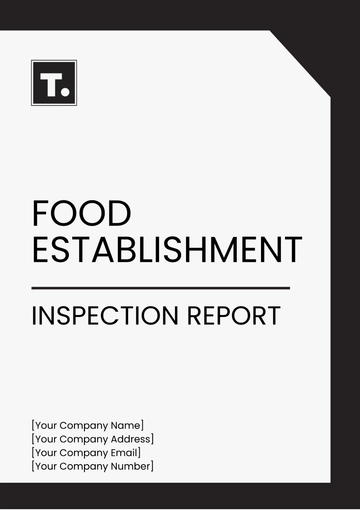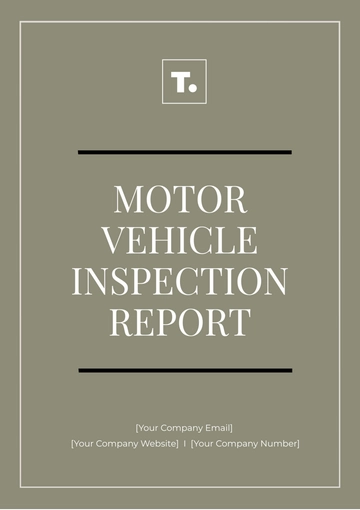Free Aesthetic Hospitality Industry Safety Inspection Report

Prepared by: [Your Name]
Company: [Your Company Name]
Date: April 1, 2060
1. Executive Summary
The safety inspection of the hospitality industry, conducted from January to March 2050, aimed to evaluate compliance with established safety standards across various sectors within the industry. The inspection covered a broad spectrum, including hotels, restaurants, and event venues. This report presents the findings, highlights critical areas for improvement, and provides actionable recommendations to enhance safety protocols. Key areas of concern included fire safety, sanitation practices, employee training, and emergency preparedness. By addressing these gaps, the hospitality industry can improve safety and continue to ensure a secure environment for both guests and staff.
2. Introduction
Safety is a cornerstone of the hospitality industry, not only to protect the well-being of guests but also to ensure the safety of employees and the reputation of the establishment. Adherence to safety standards in areas such as fire safety, sanitation, and staff training is essential to prevent accidents and maintain operational integrity. This report presents the results of a comprehensive safety inspection of 50 establishments in various regions and operational contexts, evaluating their adherence to industry safety protocols and identifying areas for improvement.
3. Methodology
The inspection employed a systematic approach to assess compliance with key safety standards. This ensured consistency across all evaluated establishments and allowed for actionable insights.
Sample Selection
A random selection of 50 establishments was made, encompassing a variety of sizes, geographical locations, and types of operations (hotels, restaurants, event venues). This diverse selection helped provide a comprehensive overview of safety standards across the hospitality sector.Inspection Framework
A standardized checklist was used, focusing on the following areas:Fire safety: fire extinguishers, emergency exits, smoke detectors
Health and sanitation: kitchen cleanliness, restroom maintenance, guest room conditions
Staff training: emergency protocols, first aid knowledge
Data Collection
Data was gathered through on-site observations, interviews with staff members, and reviews of relevant documents (e.g., maintenance logs, sanitation records). Each establishment was assessed against the criteria on the checklist, and non-compliance was noted for further analysis.
4. Findings
4.1 Fire Safety
Fire safety is a critical area in the hospitality industry, with compliance levels varying significantly across establishments. Key findings include:
Aspect | Compliance Rate | Comments |
|---|---|---|
Fire Extinguishers | 82% | The majority of facilities were equipped, but maintenance logs were not consistently updated. |
Emergency Exits | 75% | Some exits were obstructed or improperly marked, particularly in older buildings. |
Smoke Detectors | 90% | High compliance due to mandatory checks, but several installations were found faulty. |
Key Issues Identified:
Unmaintained Equipment: Lack of updated maintenance logs for fire extinguishers, which may impact readiness during emergencies.
Obstructed Exits: Older buildings may have inadequate emergency exits, either due to design or obstruction by stored items.
Faulty Detectors: While smoke detectors were commonly installed, some were malfunctioning, which poses a significant risk in the event of a fire.
4.2 Health and Sanitation
Sanitation is essential for both guest safety and the prevention of health hazards. While most facilities met basic cleanliness standards, areas for improvement were noted.
Area | Compliance Rate | Comments |
|---|---|---|
Kitchens | 85% | Generally clean, though pest control was inconsistent due to lapses in regular inspections. |
Restrooms | 88% | Cleanliness was generally maintained, but some lacked adequate sanitation supplies (e.g., soap, paper towels). |
Guest Rooms | 90% | Cleanliness was maintained, but allergen monitoring was insufficient in some rooms. |
Key Issues Identified:
Pest Control: Some kitchens were found with pest issues, attributed to inconsistent pest control measures.
Sanitation Supplies: Restrooms in certain facilities lacked necessary sanitation supplies, impacting hygiene standards.
Allergen Management: Guest rooms did not always have systems in place to manage allergens, which is important for guests with allergies.
4.3 Staff Training
Staff training is essential to ensure quick and effective response in emergencies and to maintain a high level of safety awareness.
Training Area | Compliance Rate | Comments |
|---|---|---|
Emergency Procedures | 65% | A significant gap in staff awareness of emergency protocols. |
First Aid Certification | 50% | Only half of the staff had valid first aid certification, reflecting a lack of ongoing training. |
Key Issues Identified:
Insufficient Training: Many staff members were not familiar with emergency procedures, indicating gaps in regular training programs.
Lack of First Aid Certification: Only half of the staff were certified in first aid, suggesting a need for better training and certification programs.
5. Recommendations
5.1 Fire Safety Enhancements
Improve Equipment Maintenance: Implement digital logs for fire extinguisher checks and ensure periodic maintenance. Consider the use of automated alerts for upcoming maintenance due dates.
Address Emergency Exit Issues: Ensure all emergency exits are clearly marked and unobstructed. Conduct regular inspections to ensure compliance, especially in older buildings.
Upgrade Smoke Detectors: Ensure all smoke detectors are fully operational and replace faulty units. Implement regular testing schedules to maintain compliance.
5.2 Health and Sanitation Improvements
Strengthen Pest Control Measures: Establish routine pest inspections and enforce pest control protocols to prevent infestations, particularly in kitchens and food storage areas.
Monitor Restroom Sanitation: Conduct regular audits to ensure restrooms are fully stocked with necessary supplies. Address any deficiencies promptly.
Implement Allergen Management Systems: Introduce allergen monitoring systems in guest rooms and ensure staff are trained to handle allergy-related incidents.
5.3 Staff Training Programs
Emergency Training: Regularly conduct emergency procedure training for all employees, with annual refresher courses to ensure knowledge retention.
First Aid Certification: Develop a comprehensive first aid training program and ensure all staff are certified. Implement a policy that mandates first aid training upon hiring and during periodic training sessions.
5.4 Continuous Monitoring and Auditing
Safety Audits: Implement regular, internal safety audits to track compliance with fire safety, sanitation, and staff training protocols.
Guest Feedback: Encourage guest feedback on safety and sanitation standards to identify potential issues that may not be immediately visible during inspections.
6. Conclusion
The hospitality industry continues to make significant strides in maintaining safety standards, but there are critical areas where improvements are necessary. Addressing the identified issues—such as fire safety maintenance, sanitation practices, and staff training—will improve safety across the sector. By adopting the recommended changes, hospitality establishments can better safeguard the well-being of both guests and staff, fostering a safer and more compliant environment.
- 100% Customizable, free editor
- Access 1 Million+ Templates, photo’s & graphics
- Download or share as a template
- Click and replace photos, graphics, text, backgrounds
- Resize, crop, AI write & more
- Access advanced editor
The Aesthetic Hospitality Industry Safety Inspection Report Template from Template.net offers a professional, editable solution for safety assessments. Fully customizable, it allows you to modify content to suit your needs. Easily editable in our AI Editor Tool, this template ensures efficient and accurate inspections, enhancing safety compliance and streamlining your reporting process.
You may also like
- Sales Report
- Daily Report
- Project Report
- Business Report
- Weekly Report
- Incident Report
- Annual Report
- Report Layout
- Report Design
- Progress Report
- Marketing Report
- Company Report
- Monthly Report
- Audit Report
- Status Report
- School Report
- Reports Hr
- Management Report
- Project Status Report
- Handover Report
- Health And Safety Report
- Restaurant Report
- Construction Report
- Research Report
- Evaluation Report
- Investigation Report
- Employee Report
- Advertising Report
- Weekly Status Report
- Project Management Report
- Finance Report
- Service Report
- Technical Report
- Meeting Report
- Quarterly Report
- Inspection Report
- Medical Report
- Test Report
- Summary Report
- Inventory Report
- Valuation Report
- Operations Report
- Payroll Report
- Training Report
- Job Report
- Case Report
- Performance Report
- Board Report
- Internal Audit Report
- Student Report
- Monthly Management Report
- Small Business Report
- Accident Report
- Call Center Report
- Activity Report
- IT and Software Report
- Internship Report
- Visit Report
- Product Report
- Book Report
- Property Report
- Recruitment Report
- University Report
- Event Report
- SEO Report
- Conference Report
- Narrative Report
- Nursing Home Report
- Preschool Report
- Call Report
- Customer Report
- Employee Incident Report
- Accomplishment Report
- Social Media Report
- Work From Home Report
- Security Report
- Damage Report
- Quality Report
- Internal Report
- Nurse Report
- Real Estate Report
- Hotel Report
- Equipment Report
- Credit Report
- Field Report
- Non Profit Report
- Maintenance Report
- News Report
- Survey Report
- Executive Report
- Law Firm Report
- Advertising Agency Report
- Interior Design Report
- Travel Agency Report
- Stock Report
- Salon Report
- Bug Report
- Workplace Report
- Action Report
- Investor Report
- Cleaning Services Report
- Consulting Report
- Freelancer Report
- Site Visit Report
- Trip Report
- Classroom Observation Report
- Vehicle Report
- Final Report
- Software Report





























